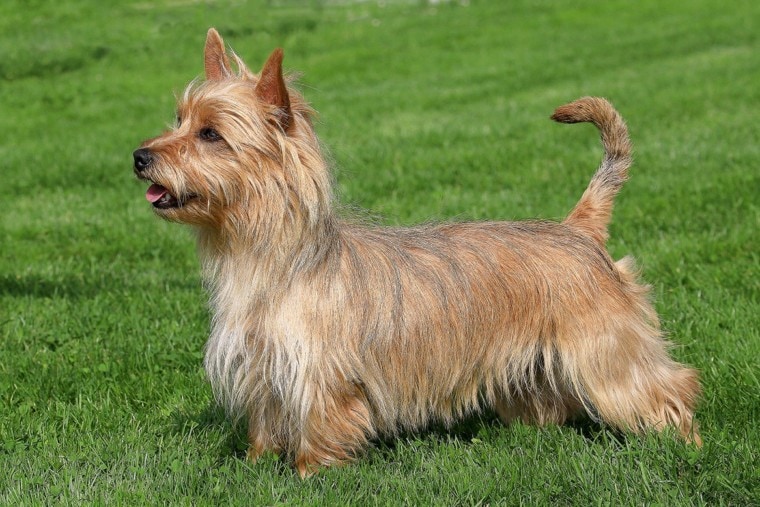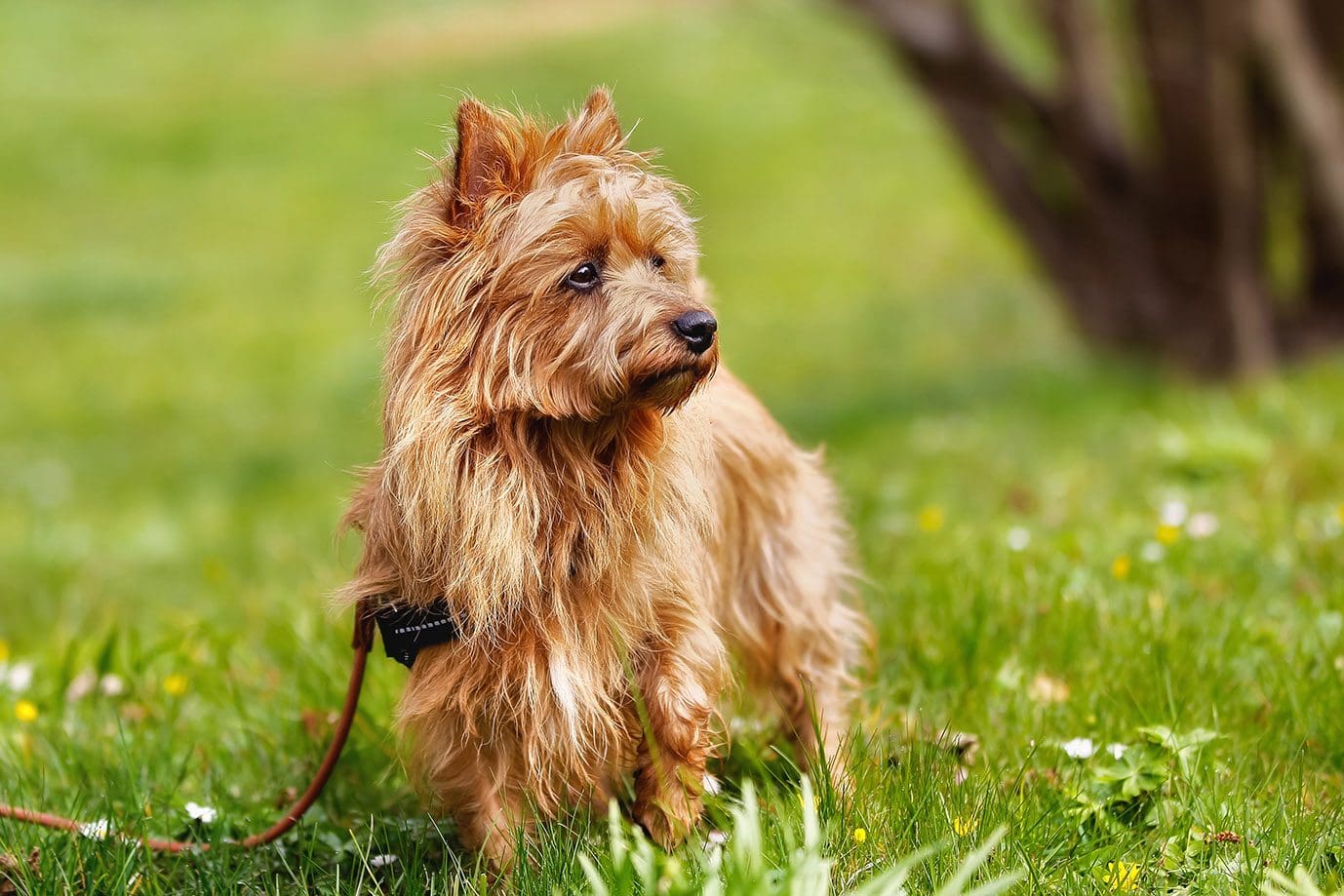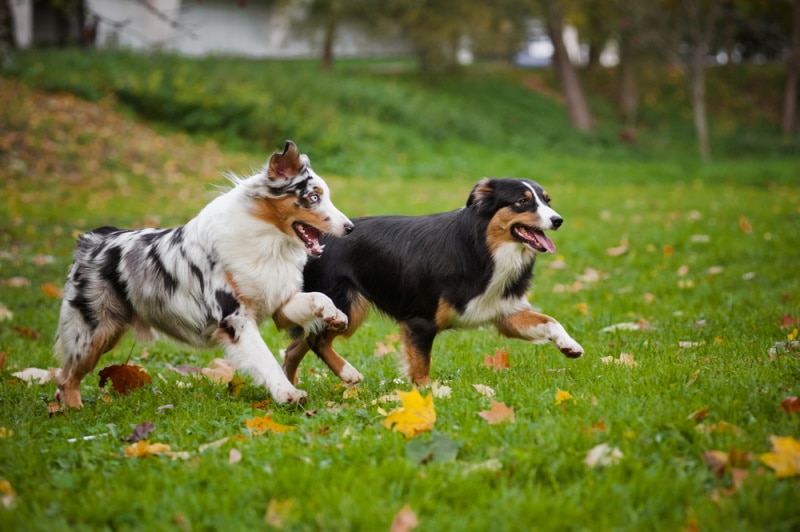
Click Below to Skip Ahead
Terriers are the spice of life—they’re spunky, sassy, and easy to love. Australian Terriers are no exception. These little dogs will keep you on your toes with their quickness and activity. You will have lots of laughs watching them interact with other critters and kids.
Breed Overview
Height:
9 – 11 inches
Weight:
12 – 16 pounds
Lifespan:
12 – 15 years
Colors:
Blue & tan, sand, red
Suitable for:
Active families, apartment living
Temperament:
Spirited, spunky, energetic, happy-go-lucky, bossy
Of course, there are a few things we should go over that might not work for everyone—like their inclination to bark. So, let’s go over every aspect of owning an Australian Terrier to see if they match your criteria for the next family pet.
Australian Terrier Characteristics
Australian Terrier Puppies

When you’re looking for an Australian Terrier puppy, it’s essential to select a breeder with a favorable reputation. These people should produce quality, healthy specimens that bring solidity to the breed. Puppies might require deposits and should come home with vetting—including their first round of shots. You might get lucky and find an Aussie at a local rescue or shelter. If you do, the pup will be thoroughly vetted, including shots, spay or neuter, necessary medications, and diagnosis of any ailments.
When you bring an Australian Terrier home, be ready to have an energetic pup by your side. Make sure you have enough time and energy to offer them enough physical and mental stimulation to avoid boredom.
Temperament & Intelligence of the Australian Terrier
Australian Terriers have a spitfire personality that is both entertaining and adorable. They will aim to impress with their bold actions and spunky spirit.
These dogs are agile, quick, and energetic, always bustling around, so they don’t miss anything. Like most terriers, these dogs can be bossy, fussy, and demanding, but you will learn quickly to appreciate their quirks. Their bark is much bigger than their bite.
These dogs are exceptionally watchful and adventurous. They notice every squirrel, blowing leaf, and strange barks in the distance. Because of their attentiveness and barking tendencies, they make excellent watchdogs—even if they can’t do much damage to an intruder.
They are brilliant little dogs, which have their ups and downs. While they can easily train, it might be up in the air depending on their mood. These dogs tend to do what they want more than what you want them to do.
If you keep a firm hand and a positive mindset, their independent nature can work fine in just about any situation.
Are These Dogs Good for Families? 👪
These dogs make fabulous family additions for most people. They get along well with children, older adults, and some strangers. But because they look at children as equals, they won’t be afraid to show them if they dislike something—sometimes resulting in nipping.
They also won’t take kindly to being teased, so teaching your child respect very early is important. They can be possessive with their toys and belongings, so discourage your child from taking objects.
When they are adequately trained and socialized, these behaviors are often averted. Australian Terriers can be fabulous playmates and companions who don’t exhibit negative traits.
Does This Breed Get Along with Other Pets?
Australian Terriers can absolutely get along with other pets—especially if they grow up together. They are notorious for being bossy little things—especially to bigger dogs. While this behavior is typically harmless, another dog might perceive this as a threat—so exercise caution.
An Australian Terrier might chase your cats from time to time, but they won’t do much harm. Your cat is likely to swat them away. Their small size prevents them from being able to really win that fight. But they usually get along very well with cats, even if they like to bug them.
Australian Terriers are entirely incompatible with smaller prey animals—they can seriously hurt or kill them. It’s not out of meanness—they just have this quality in their DNA. Always prevent any meeting, as your Aussie will be lightning quick.

Things to Know When Owning an Australian Terrier:
Food & Diet Requirements 🦴
Some small breeds can be finicky about what they eat—but the Australian Terrier usually isn’t among them. Even though they have a love for food, they aren’t prone to overeating or obesity.
You can feed your Aussie a top-quality dry kibble, wet food, raw food, or homemade diet. However, if you choose to make your own, always have the recipe approved by your vet. Adding or leaving out certain ingredients can harm your dog’s health.
Always feed your Australian Terrier based on their age and weight, following the measurement instructions on your chosen diet.
Exercise 🐕
You probably won’t have an issue convincing your Aussie that it’s time for a walk. On the contrary, they might be the ones coaxing you along. They really prefer interactive games like frisbee and catch—and it’s not unusual that they have a favorite ball for playtime.
Your Aussie needs roughly 30 to 60 minutes of high-intensity exercise per day to stay their healthiest.
Your Aussie will be happy letting you sit back in a lawn chair as long as you’re ready to throw the ball when they drop it at your side. So, they might not require the same activity from you. Just provide them lots of stimulating things to do to keep them happy.

Training 🎾
Australian Terriers can do very well with training, attitude depending. Some Aussies can be ornery, spirited, and stubborn. They might not always be up for learning since they have better things to do. Keeping their focus might be the hardest part.
But don’t let that deter you. With consistency and positive reinforcement, you can train the Aussie to perform tricks, learn basic commands and good manners.
When it comes to potty training, they aren’t as complicated as some other small breeds. Most owners say that their Aussies do best with crate training. Try to avoid puppy pads if you can. Some dogs who use puppy pads may end up with lifelong behaviors because peeing on a pad is more convenient.
Grooming ✂️
You might be surprised to learn that Aussies only require a bath four times per year. It would be best if you took them to a professional groomer to have their fur trimmed and stripped to maintain shape.
As with other dogs, your Aussie will need a full bath every 4-6 weeks, depending on coat condition. Keep nailed trimmed, ears cleaned, and teeth brushed.

Health and Conditions 🏥
Australian Terriers are pretty healthy dogs, but the breed is prone to certain health issues over others. To stay on top of things, it’s essential to keep up with regular vet appointments. During the first year, you will have to go frequently for vaccines and checkups.
Once they reach adulthood, appointments will switch to biannual or annual—depending on your dog and vet. If they develop any concerns, your vet can work with you through the problems to create solutions.
Minor Conditions
Serious Conditions
Male vs. Female
There are some notable differences between male and female Australian Terriers. Males tend to be larger with broader bodies, but both genders have lean, toned frames.
As far as personality is concerned, both genders have spitfire traits that can pose various challenges. Unlike some other breeds that show distinct personality variations between the genders, the Aussie isn’t one of them.
You might have a sweet-natured male that hates other dogs of the same sex—but you might also have that with a female. You could have a female who prefers her family and her family only and a male that exhibits the same.
It very much depends on the individual pup—not the gender. So choose a puppy that matches you. Chemistry can tell you all about compatibility.
3 Little-Known Facts About the Australian Terrier
1. Like Most Terriers, Australian Terriers Are Highly Vocal Dogs
Australian Terriers are not afraid to show how they feel—which includes voicing their opinion. These dogs won’t hesitate to bark, yip, yelp, and yap at every passerby, friend or foe.
2. Australian Terriers Are (More Than a Little) Stubborn
Blame it on their terrier nature. These dogs will constantly have you questioning exactly which one of you is really the boss here. Their enthusiastic, brave nature will have you frustrated one minute and belly-laughing the next.
3. Australian Terriers Are Not Outdoor Dogs
Aussies are not good candidates for outdoor living. They are tiny, ill-equipped for extreme weather—plus, they can jump, slip, or dig out of just about any enclosure.

Final Thoughts
If the zippy energy and larger-than-life attitude of the Australian Terrier sound like a perfect fit for your lifestyle, it’s time to look for reputable breeders near you. Remember to make sure each puppy is healthy, preferably registered, and comes with vetting included.
Don’t be afraid to check your area for local shelters and rescues that just may have an Australian Terrier for the taking. You could easily give an awesome dog a new life at a fraction of the cost of a brand-new puppy.
Related Reading:
- 12 Small Dog Breeds (with Pictures)
- 15 Terrier Dog Breeds (with Pictures)
- Terri-Poo (Australian Terrier & Poodle Mix)
Featured Image Credit: Radomir Rezny, Shutterstock








